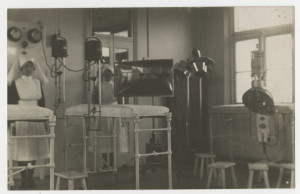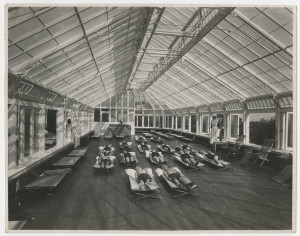Heliotherapy, or sunlight treatment, was one of the key therapeutic measures used by sanatoria to tackle tuberculosis and in this respect Stannington was no different. Most sanatoria were built in the countryside where patients could benefit from fresh air whilst receiving plenty of rest and a good diet. In addition to this sunlight, whether real or artificial, was an essential component in aiding recovery based on the principle that it would strengthen the patient and better enable them to fight off the disease. Many of the photographs of children in the sanatorium from the collection show them to be outside on most occasions whether they be in school, in bed, or taking part in leisure activities.

Stannington had been using arc lamps since 1920 in the treatment of skin lesions and ulcers with the aim of speeding up the healing process of such lesions by exposing them directly to the light. In 1926, however, a large artificial light department was introduced and equipped with ultraviolet apparatus to allow patients suffering from various forms of TB to be treated and to continue to receive light treatment even in adverse weather conditions. Patients may have been required to spend time in the artificial light room for several minutes each day for as long as it was seen to be beneficial. For many patients with mild cases of tuberculosis, or where there were no surgical options, this may have been their main and only active course treatment.

Children at rest in the vita glass pavilion
One very notable part of the sanatorium buildings was the vita-glass sun pavilion, built in 1927 thanks to the generosity of an anonymous donor, and opened by the Duchess of Northumberland. It had the capacity to house 50 patients and was used primarily in the treatment of those with pulmonary TB. Vita glass is designed to allow ultraviolet rays to penetrate easily and the pavilion meant that the children could enjoy natural sunlight whilst being protected from the elements.
Sources:
T. C. Hunter, ‘Associations and Institutions: Stannington Sanatorium, Northumberland’, The British Journal of Tuberculosis, 1930, 24, 28-32.
R. A. Hobday, ‘Sunlight Therapy and Solar Architecture’, Medical History, 1997, 42, 455-472.
